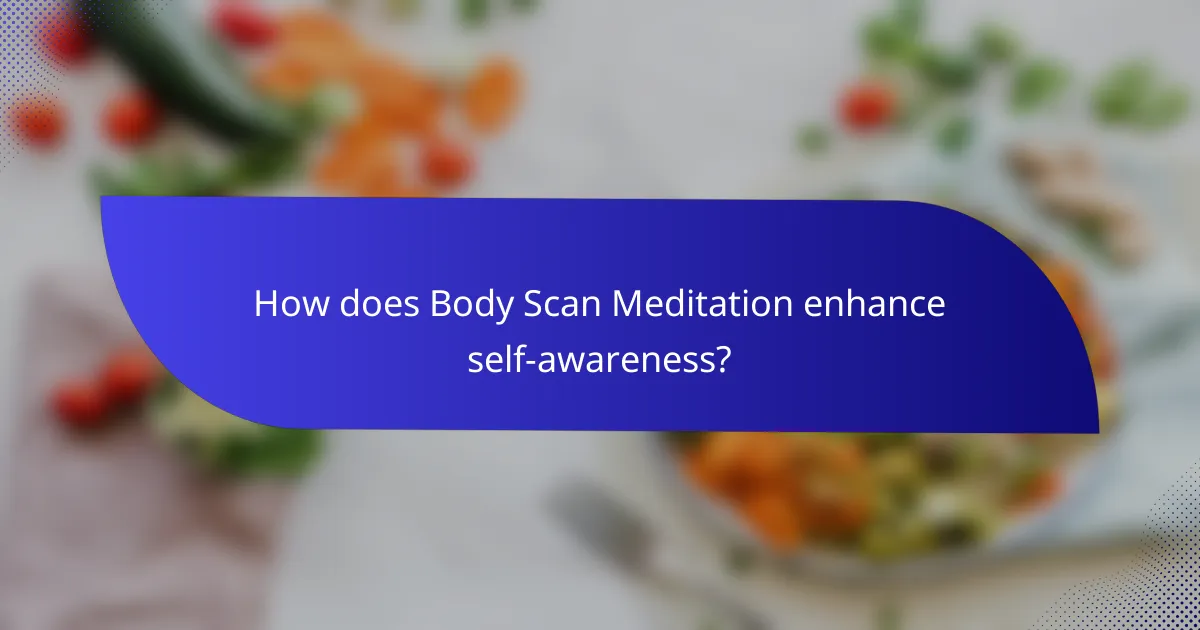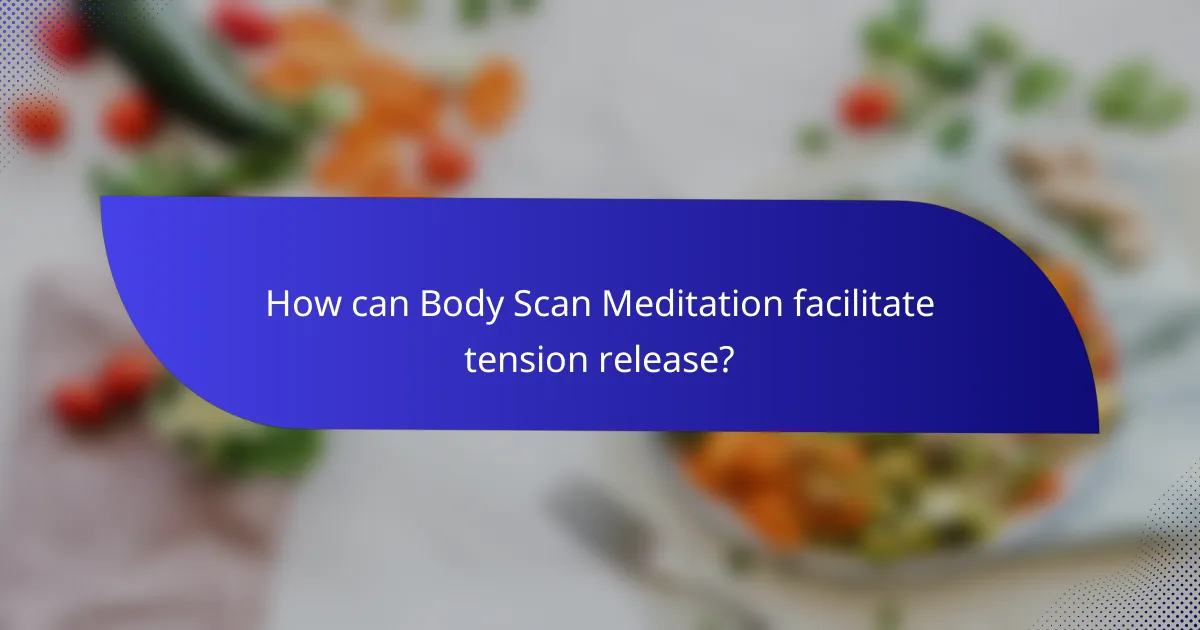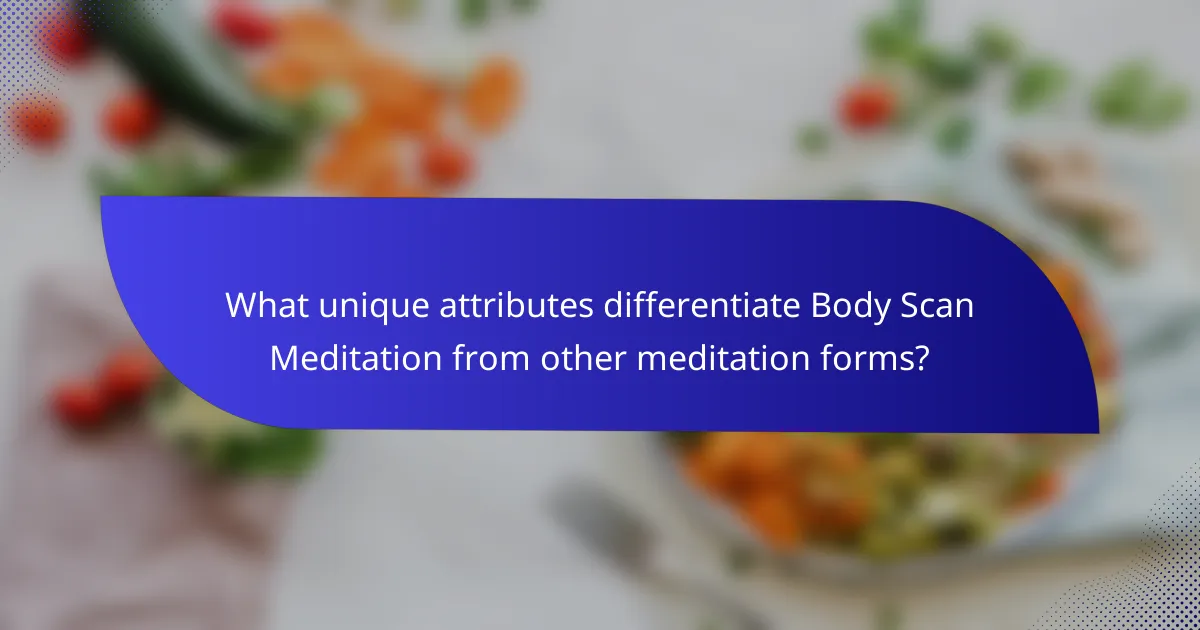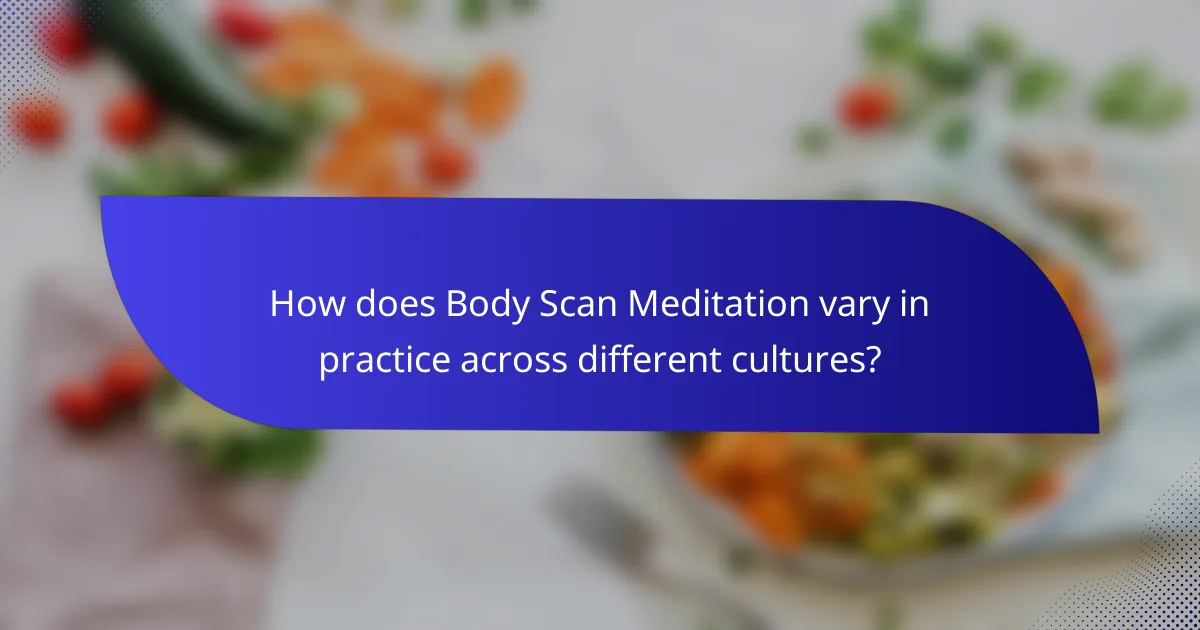Body scan meditation enhances self-awareness and promotes tension release by fostering a deeper connection between mind and body. This practice systematically focuses on physical sensations, helping identify areas of tension. Regular engagement can lead to reduced stress and improved emotional regulation. Additionally, cultural variations in practice enrich its adaptability and effectiveness across different populations.

How does Body Scan Meditation enhance self-awareness?
Body scan meditation significantly enhances self-awareness by fostering a deeper connection between mind and body. This practice encourages individuals to focus on physical sensations, promoting mindfulness and introspection. As practitioners systematically observe their body, they identify areas of tension and discomfort, which can lead to greater emotional awareness and regulation.
Additionally, research indicates that body scan meditation can reduce stress levels, further enhancing self-awareness by creating a calmer mental state. This process allows individuals to reflect on their thoughts and emotions without judgment, leading to improved self-acceptance and personal growth. Regular practice cultivates a unique attribute of heightened sensitivity to bodily signals, enriching the overall meditation experience.
What are the psychological benefits of increased awareness through meditation?
Increased awareness through body scan meditation enhances psychological well-being by reducing stress, improving emotional regulation, and fostering greater self-acceptance. This practice encourages individuals to connect with their physical sensations, promoting mindfulness and presence. Research indicates that regular engagement in body scan meditation can lead to decreased anxiety and improved mood. The unique attribute of this technique lies in its ability to cultivate a non-judgmental awareness of bodily experiences, facilitating tension release and emotional clarity. As a result, practitioners often report increased resilience and a deeper understanding of their mental states.
Which techniques improve mindfulness during Body Scan Meditation?
To improve mindfulness during Body Scan Meditation, focus on intentional breathing, progressive muscle relaxation, and maintaining a non-judgmental awareness. These techniques enhance body awareness and facilitate tension release.
Intentional breathing involves deep, slow breaths to anchor attention and promote relaxation. Progressive muscle relaxation encourages the release of tension by systematically tensing and relaxing muscle groups. Maintaining non-judgmental awareness allows practitioners to observe sensations without attachment, promoting a deeper connection to the present moment.
Incorporating these techniques can lead to a more effective and enriching Body Scan Meditation experience.

How can Body Scan Meditation facilitate tension release?
Body scan meditation effectively facilitates tension release by promoting mindfulness and body awareness. This practice encourages individuals to focus on physical sensations, helping to identify areas of tension. By consciously relaxing these areas, participants often experience a significant reduction in stress and anxiety levels. Research indicates that regular body scan meditation can lead to improved emotional regulation and overall well-being. Additionally, this technique fosters a deeper connection between mind and body, enhancing self-awareness and promoting a sense of calm.
What physiological responses occur during tension release?
Body scan meditation triggers various physiological responses that enhance awareness and promote tension release. These responses include reduced heart rate, decreased muscle tension, and improved respiratory function. As a result, participants often experience a sense of calm and relaxation. This practice also encourages mindfulness, allowing individuals to connect with their bodies and recognize areas of stress. By focusing attention on specific body parts, practitioners can identify and release stored tension effectively.
Which common areas of tension can be addressed through this practice?
Body scan meditation effectively addresses common areas of tension such as muscle tightness, stress, anxiety, and emotional discomfort. By promoting awareness of bodily sensations, it helps individuals identify and release tension in specific areas. This practice enhances relaxation and fosters a deeper connection between mind and body. Regular engagement can lead to improved overall well-being and resilience against stress.

What unique attributes differentiate Body Scan Meditation from other meditation forms?
Body Scan Meditation uniquely emphasizes bodily awareness and tension release, setting it apart from other forms. This technique involves a systematic focus on different body parts, promoting mindfulness and relaxation. It fosters a deeper connection between mind and body, enhancing emotional regulation. Unlike other meditation practices, Body Scan Meditation specifically targets physical sensations, making it effective for stress relief and pain management. This unique attribute makes it particularly beneficial for individuals seeking to increase awareness of their bodily states and release tension effectively.
How does the focus on bodily sensations enhance the meditation experience?
Focusing on bodily sensations enhances meditation by promoting mindfulness and facilitating tension release. This practice encourages individuals to tune into their physical state, increasing awareness of stress and discomfort. As a result, participants can identify and address areas of tension, leading to a more profound sense of relaxation. Engaging with bodily sensations fosters a deeper connection to the present moment, which is essential for effective meditation.
What makes Body Scan Meditation particularly effective for stress relief?
Body Scan Meditation is particularly effective for stress relief because it enhances body awareness and promotes tension release. This practice encourages individuals to focus on physical sensations, helping to identify areas of stress. By systematically scanning the body, practitioners can consciously relax tense muscles, leading to a reduction in overall stress levels. Research indicates that mindfulness techniques, including body scan meditation, can lower cortisol levels, which is a key stress hormone. Additionally, this meditation form fosters a sense of presence, allowing individuals to break free from anxiety-provoking thoughts.

Which practical steps can beginners take to start Body Scan Meditation?
Beginners can start Body Scan Meditation by following these practical steps. Begin by finding a quiet space where you can sit or lie down comfortably. Close your eyes and take several deep breaths to center your mind. Focus your attention on your toes, noticing any sensations or tension. Gradually move your awareness up through your feet, legs, abdomen, and so on, until you reach the top of your head. Allow yourself to release any tension you feel in each body part as you focus on it. Practice this meditation for 10 to 20 minutes daily to enhance awareness and promote relaxation.
What are the recommended durations and frequencies for practice?
For effective body scan meditation, practice sessions should last 20 to 30 minutes, ideally done 3 to 5 times per week. Consistent practice enhances awareness and promotes tension release over time. Starting with shorter durations can help build comfort and focus, gradually increasing as experience grows.
How can one create a conducive environment for meditation?
Creating a conducive environment for meditation involves minimizing distractions and enhancing comfort. Choose a quiet space with soft lighting and a comfortable temperature. Use cushions or mats to support your body. Incorporate calming scents like lavender or sandalwood to promote relaxation.
Consider the noise level; soft background music or nature sounds can enhance focus. Ensure good ventilation for fresh air flow. Personalize the space with items that inspire peace, such as plants or artwork. Regularly maintaining this environment reinforces the habit of meditation, aiding in increased awareness and tension release.

What are the common challenges faced during Body Scan Meditation?
Common challenges during Body Scan Meditation include difficulty maintaining focus, physical discomfort, emotional resistance, and impatience with the process. These obstacles can hinder the experience of increased awareness and tension release. Practitioners may struggle to remain present, leading to distractions and a lack of mindfulness. Physical discomfort may arise from prolonged stillness, while emotional resistance can surface as feelings of anxiety or restlessness. Lastly, impatience can disrupt the flow of the practice, making it challenging to fully engage with the body scan.
How can distractions be managed effectively during practice?
To manage distractions effectively during practice, incorporate body scan meditation. This technique enhances awareness and promotes tension release. Begin by finding a quiet space to sit or lie down comfortably. Focus on each body part sequentially, noticing sensations, tension, or discomfort. Acknowledge distractions without judgment, then gently redirect your attention back to the body scan. Regular practice builds mental resilience against distractions, creating a more focused and peaceful state during sessions.
What strategies can help maintain focus throughout the session?
To maintain focus during body scan meditation, employ strategies that enhance awareness and promote relaxation. First, establish a quiet environment to minimize distractions. Next, practice deep breathing to center your mind. Incorporate gentle reminders to return focus when thoughts wander. Use a guided meditation app for structure and support. Finally, set a specific duration for the practice to create a sense of commitment.

How does Body Scan Meditation vary in practice across different cultures?
Body scan meditation practices vary significantly across cultures, reflecting diverse spiritual and therapeutic traditions. In Western contexts, it often emphasizes mindfulness and psychological benefits, focusing on awareness and tension release. Conversely, Eastern practices may integrate body scan techniques within broader meditative frameworks, emphasizing energy flow and spiritual connection.
For example, in Buddhist traditions, body scanning serves as a tool for deepening awareness and cultivating compassion. In contrast, some Western therapeutic approaches prioritize stress reduction and relaxation through structured body awareness exercises.
Cultural variations also influence the duration and setting of practice. Western methods may utilize guided sessions, while Eastern traditions might encourage self-directed practices in serene environments.
Ultimately, these cultural differences shape the approach and experience of body scan meditation, enhancing its adaptability and relevance across various populations.
What are the influences of regional practices on Body Scan Meditation techniques?
Regional practices significantly influence Body Scan Meditation techniques by incorporating cultural nuances and traditional mindfulness approaches. These variations can enhance awareness and tension release through unique methods. For instance, some regions emphasize breath control, while others focus on sensory experiences. The integration of local beliefs may also shape the meditation’s intent, making it more relatable. This cultural infusion enriches the practice, allowing individuals to connect deeply with their experiences.
Which cultural adaptations have emerged in modern meditation practices?
Modern meditation practices have adapted various cultural elements, particularly within Body Scan Meditation. This technique incorporates mindfulness principles from Eastern traditions while integrating Western psychological insights.
The practice emphasizes increased awareness of bodily sensations, promoting relaxation and tension release. It encourages participants to focus on each body part sequentially, enhancing the mind-body connection.
Cultural adaptations also include the use of technology, such as apps and online classes, making Body Scan Meditation more accessible. These innovations cater to diverse audiences, reflecting a blend of traditional practices and contemporary needs.
As a result, Body Scan Meditation has evolved to fit modern lifestyles, appealing to individuals seeking stress relief and enhanced self-awareness.

What expert tips can enhance the effectiveness of Body Scan Meditation?
To enhance the effectiveness of Body Scan Meditation, focus on consistency, environment, and mindfulness techniques. Establish a regular practice schedule to build familiarity. Choose a quiet, comfortable space free from distractions to deepen relaxation. Incorporate breathing exercises to promote awareness of bodily sensations. Use guided meditations to maintain focus and structure. Experiment with durations to find what works best for you, as individual preferences vary.
What are the best practices for integrating Body Scan Meditation into daily life?
Integrating Body Scan Meditation into daily life enhances awareness and facilitates tension release. Start by setting aside time daily, even if just five minutes.
Create a dedicated space for meditation, free from distractions. Use guided recordings or apps for support, especially when beginning.
Incorporate the practice into existing routines, such as before sleep or after waking. Focus on breathing and body awareness during activities, like walking or stretching, to deepen the experience.
Finally, maintain consistency by tracking progress and reflecting on benefits, which reinforces commitment to the practice.
What common mistakes should be avoided to maximize benefits?
To maximize benefits from body scan meditation, avoid common mistakes such as rushing through the practice, neglecting to find a quiet space, and failing to focus on bodily sensations. Prioritize a relaxed environment to enhance awareness and tension release. Consistency is key; practice regularly to deepen the experience.